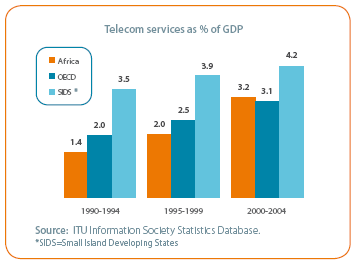|
chapter
three: business.digital
However you look at it, digital business is big
business. The clearest evidence for this is at the macro-economic
level, where the contribution of ICTs to the general economy has
grown rapidly, regardless of falling prices. In 2004,
telecommunication services contributed some 3.3 per cent of Gross
Domestic Product (GDP) worldwide, compared with just 1.8 per cent in
1990, with virtually every single world economy enjoying growth.
  On the mobile side, the exorbitant prices
paid for 3G licenses, which seemed extortionate after the
collapse of the IT bubble, now seem more reasonable,
particularly given the ongoing expansion of the mobile
sector to reach 2.17 billion subscribers at the end of 2005.
Of these subscribers, just over ten per cent have already
shifted to third generation mobile systems (3G). The reality
is that, despite the severity of the crash that affected the
technology sector between 2000 and 2003, the underlying
networks have simply kept growing with barely a hiccup. Key factors driving growth include
higher-capacity, user-friendly services and a shift to
flat-rate billing models. In the mobile broadband market,
Japan and the Republic of Korea were early leaders, but
Italy and the United Kingdom are catching up fast. However,
mobile broadband suffers from the same limitations as
fixed-line broadband, when it was first introduced at the
turn of the millennium. In many cases, it is complex to use
and the quality of service (e.g. for viewing video clips) is
sometimes poor, due to capacity constraints, and prices
remain high. However, the problems of capacity, quality and
price should be resolved as W-CDMA networks shift to HSDPA
and CDMA 2000 1x networks are upgraded to EV-DV and EV-DO.
The development of fixed wireless services, such as WiMAX,
and the use of dualmode handsets and data cards will
increasingly blur differences between different platforms.
Ultimately, the goal is to deliver access
to consumers more cheaply and conveniently. Improving
technical capabilities of mobile networks will help increase
the overall range of delivery platforms available to
consumers. As platforms diversify,
 inter-modal competition
will become more important. Those economies that have
historically shown the fastest growth in broadband are those
in which end-users have the most choice, for instance
between DSL, cable modems, fibre to the home, and now 3G
mobile broadband as well. inter-modal competition
will become more important. Those economies that have
historically shown the fastest growth in broadband are those
in which end-users have the most choice, for instance
between DSL, cable modems, fibre to the home, and now 3G
mobile broadband as well.
The
requirements of end-users are increasingly at the forefront, as
businesses place greater emphasis on understanding demand,
particularly in saturated markets. In this respect, the growing
trend towards the personalization of services and user-generated
value is having a significant impact on re-shaping the industry.
First of all, end-users are generating a higher share of networks
investment than in the past, as more and more equipment is now owned
directly by end-users (e.g. broadband routers). Second, a higher
percentage of revenue now derives from subscription charges and
advertising, than from usage charges. Markets are also increasingly
global, with a greater share of both revenue and innovation coming
from outside the home market of service providers. Finally,
competition between different technology platforms is now just as
significant as competition within the same market. All of these
factors have an impact on business, but also on policy formulation,
which requires a much more integrated approach, and less reliance on
traditional sector-specific regulation.
|